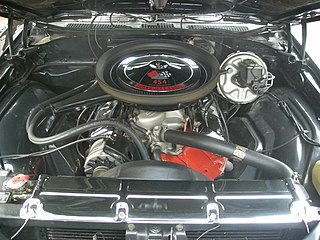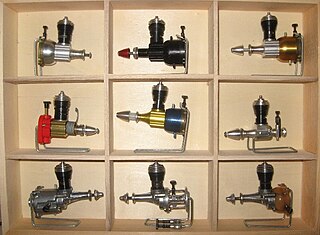
CVCC, or Compound Vortex Controlled Combustion, is an internal combustion engine technology developed and trademarked by the Honda Motor Company.

The Ford 335 engine family was a group of engines built by the Ford Motor Company between 1969 and 1982. The "335" designation reflected Ford management's decision to produce an engine of that size with room for expansion during its development. This engine family began production in late 1969 with a 351 cu in (5.8 L) engine, commonly called the 351C. It later expanded to include a 400 cu in (6.6 L) engine which used a taller version of the engine block, commonly referred to as a tall deck engine block, a 351 cu in (5.8 L) tall deck variant, called the 351M, and a 302 cu in (4.9 L) engine which was exclusive to Australia.

The Ford small-block is a series of 90° overhead valve small block V8 automobile engines manufactured by the Ford Motor Company from July 1961 to December 2000.

The Ford Modular engine is Ford Motor Company's overhead camshaft (OHC) V8 and V10 gasoline-powered small block engine family. Despite popular belief that the Modular engine family received its moniker from the sharing of engine parts across numerous Ford vehicle platforms, in reality, the Modular engine family was named as such by Ford Motor Company for the new "modular approach" to the setup of tooling and casting stations in the Windsor and Romeo engine manufacturing plants.

"LS engine" is the colloquial name given to the third and fourth generation small-block V8 gasoline engine used in General Motors' vehicles. The name evolved from the need to differentiate the Gen 3/Gen 4 small blocks from the original Gen 1/Gen 2 small blocks released in 1954, which are commonly referred to as "Small Block Chevrolets". The "LS" name originates from the engine RPO code of the first Gen 3 small block, the LS1, introduced in the 1997 Corvette. The term "LS engine" is used to describe any Gen 3 or Gen 4 Small Block Chevrolet, including those that do not specifically include "LS" as part of their RPO code. Sometimes referred to as an "LSx", with the lower case "x" standing in for one of the many RPO code variations of the motor, the term can cause confusion since GM now sells an aftermarket LS cylinder block named "LSX" with a capital "X". The original RPO code "LS1" is still sometimes used, if not confusingly, to describe the entire Gen 3/Gen 4 engine family.

The Chevrolet "big block" engine is a term for a series of large-displacement, naturally-aspirated, 90°, overhead valve, gasoline-powered, V-8 engines; that were developed and produced by the Chevrolet Division of General Motors, from the 1950s until present.

The Chevrolet small-block engine is a series of gasoline-powered, V-8 automobile engines, produced by the Chevrolet division of General Motors between 1954 and 2003, using the same basic engine block. Referred to as a "small-block" for its size relative to the physically much larger Chevrolet big-block engines, the small block family spanned from 262 cu in (4.3 L) to 400 cu in (6.6 L) in displacement. Engineer Ed Cole is credited with leading the design for this engine. The engine block and cylinder heads were cast at Saginaw Metal Casting Operations in Saginaw, Michigan.

The Iron Duke engine is a 151 cu in (2.5 L) Straight-4 piston engine built by the Pontiac Motor Division of General Motors from 1977 to 1993. Thereafter GM's 2.2 L OHV 4-cylinder replaced it across the entire lineup of vehicles that offered it. Although its original purpose was to serve as Pontiac's new economy car engine, it was later adapted for use in a wide variety of applications across GM's lineup in the 1980s.

The Buick V6, popularly referred to as the 3800 in its later incarnations, originally 198 cu in (3.2 L) and initially marketed as Fireball at its introduction in 1962, was a large V6 engine used by General Motors. The block is made of cast iron and all use two-valve-per-cylinder iron heads, actuated by pushrods. The engine, originally designed and manufactured in the United States, was also produced in later versions in Australia. It was the first six-cylinder engine designed exclusively for Buick products since the Buick straight-six was discontinued in 1930.

In automotive engineering a multi-valve or multivalve engine is one where each cylinder has more than two valves. A multi-valve engine has better breathing and may be able to operate at higher revolutions per minute (RPM) than a two-valve engine, delivering more power.

A flathead engine, also known as a sidevalve engine or valve-in-block engine is an internal combustion engine with its poppet valves contained within the engine block, instead of in the cylinder head, as in an overhead valve engine.

Gasoline direct injection (GDI), also known as petrol direct injection (PDI), is a mixture formation system for internal combustion engines that run on gasoline (petrol), where fuel is injected into the combustion chamber. This is distinct from manifold fuel injection systems, which inject fuel into the intake manifold.
The Family 1 is a straight-four piston engine that was developed by Opel, a former subsidiary of General Motors and now a subsidiary of PSA Group, to replace the Opel cam-in-head engines for use on mid-range cars from Opel/Vauxhall. Originally produced at the Aspern engine plant, production was moved to the Szentgotthárd engine plant in Hungary with the introduction of the DOHC version. GM do Brasil at São José dos Campos, GMDAT at Bupyeong and GM North America at Toluca also build these engines.

The intake/inlet over exhaust, or "IOE" engine, known in the US as F-head, is a four-stroke internal combustion engine whose valvetrain comprises OHV inlet valves within the cylinder head and exhaust side-valves within the engine block.

The Mitsubishi 4B1 engine is a range of all-alloy straight-4 piston engines built at Mitsubishi's Japanese "World Engine" powertrain plant in Shiga on the basis of the Global Engine Manufacturing Alliance (GEMA). Although the basic designs of the various engines are the same, their exact specifications are individually tailored for each partner. The cylinder block and other basic structural parts of the engine were jointly developed by the GEMA companies, but the intake and exhaust manifolds, the cylinder head's intake and exhaust ports, and other elements related to engine tuning were independently developed by Mitsubishi.
Joseph W. Jagersberger was an Austrian-American racecar driver.

Cox model engines are used to power small model airplanes, model cars and model boats. They were in production for more than 60 years between 1945 and 2006. The business is named for founder Leroy M. Cox. He started L.M. Cox Manufacturing Co. Inc, which later became Cox Hobbies Inc., then Cox Products, before being sold to Estes Industries, when it became Cox Models. On February 7, 2009, Estes Industries stopped producing Cox engines and sold all of their remaining inventory – mainly spare parts – to several private buyers from Canada and the US. One of the new owners of the remaining Cox engine and parts inventory has launched a website with an online store.

A T-head engine is an early type of internal combustion engine that became obsolete after World War I. It is a sidevalve engine that is distinguished from the much more common L-head by its placement of the valves. The intake valves are on one side of the engine block and the exhaust valves on the other. Seen from the end of the crankshaft, in cutaway view, the cylinder and combustion chamber resembles a T - hence the name "T-head". An L-head has all valves at the same side.

In internal combustion engines, a split-single design is a type of two-stroke where two cylinders share a single combustion chamber.

An internal combustion engine is a heat engine in which the combustion of a fuel occurs with an oxidizer in a combustion chamber that is an integral part of the working fluid flow circuit. In an internal combustion engine, the expansion of the high-temperature and high-pressure gases produced by combustion applies direct force to some component of the engine. The force is typically applied to pistons, turbine blades, a rotor, or a nozzle. This force moves the component over a distance, transforming chemical energy into kinetic energy which is used to propel, move or power whatever the engine is attached to. This replaced the external combustion engine for applications where the weight or size of an engine was more important.

















